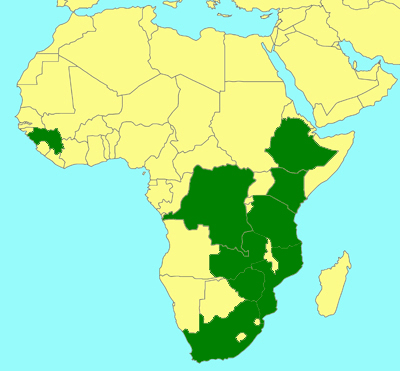Distribution
|

Democratic Republic of Congo, Ethiopia, Guinea, Kenya,
Mozambique, Tanzania, South Africa, Zambia, Zimbabwe. |
Biology
|
Use pre-existing cavities as nest sites e.g. hollow
stems, crevices in rocky situations, old bee or wasp burrows in the
ground. They use grass stems and other plant material to divide up and
seal their nest, carrying the stem beneath them in flight. Prey on grasshoppers
in the family Tettigoniidae, and crickets in the family Gryllidae and
occasionally cockroaches (Blattidae) (Bohart & Menke, 1976). |
References
|
Arnold, G. 1928.
The Sphegidae of South Africa. Part XI. Annals of the Transvaal Museum
12: 338-375. Bohart, R.M. &
Menke, A. S. 1976. Sphecid Wasps of the World: a
Generic Revision. University of California Press, Berkeley, California.
Brothers D.J. 1999. Phylogeny and
evolution of wasps, ants and bees (Hymenoptera, Chrysidoidea, Vespoidea and
Apoidea) Zoologica Scripta 28: 233–250.
Cameron, P. 1908. Hymenoptera, 7. Fossores, pp.
197-296 in Y. Sjöstedt (editor). Wissenschaftliche Ergebnisse der schwedischen
zoologischen Expedition nach dem Kilimanjaro, dem Meru und den umgebenden
Massaisteppen Deutsch-Ostafrikas 1905-1906, 2. Band, Abteilung 8-14. P.
Palmquists Aktiebolag, Stockholm. 844 pp., 10 pls. (cover dated 1910, but p. 294
dated Mar 1908).
Finnamore, A.T. & Michener, C.D. 1993. Superfamily Apoidea (pp.
279-357). In GOULET, H. & HUBER, J. (eds). Hymenoptera of the World:
an identification guide to families. Research Branch, Agriculture
Canada, Ottawa, Canada, 668 pp. |
Links
|
CATALOG OF WORLD SPHECIDAE
sensu lato (= Apoidea excluding bees) compiled by
Wojciech J. Pulawski (California Academy of Sciences). |
Credits
|
Photographs and map illustration © Simon van Noort (Iziko Museums
of South Africa), or
photographs © Diedrich
Visser (ARC, Pretoria).
|
|